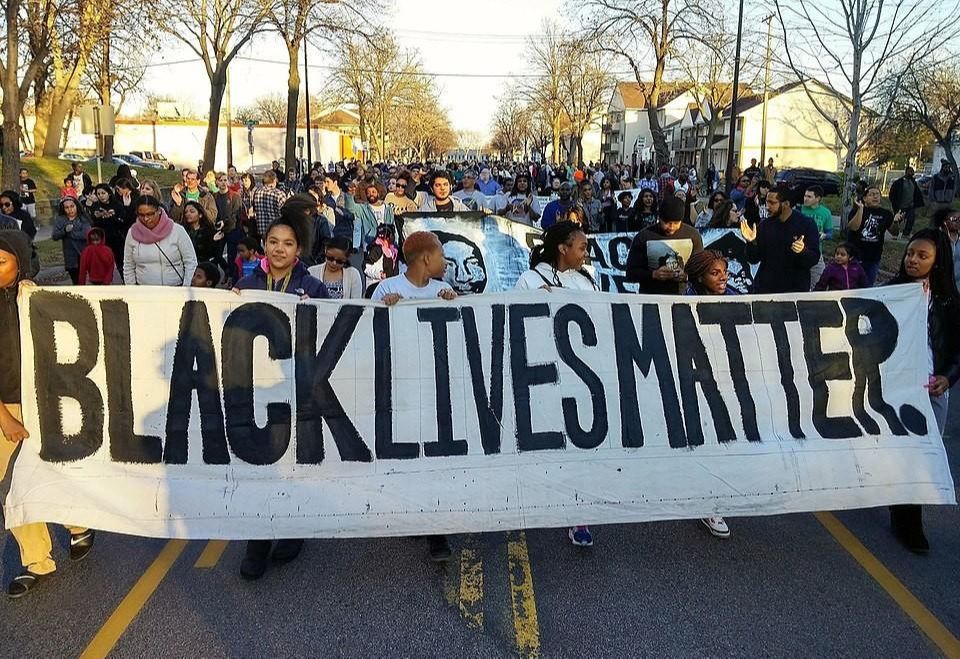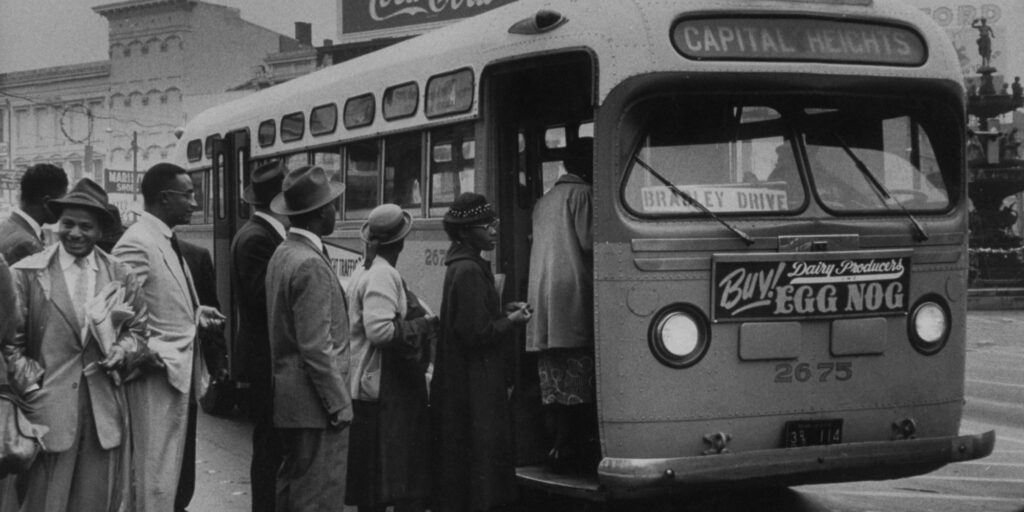Progress Isn’t Linear, But It Is Possible.
We’re living in a time where politicians and policies are rolling back basic human rights—rights we need, deserve, and should never have to fight for in the first place. It’s exhausting. But if there’s one thing you take away from this moment, let it be this: you can push through, but you cannot do it alone.
That’s where community comes in. One simple word. So much power.
History shows us time and time again that progress doesn’t move in a straight line. For every step forward, there’s often pushback. Still, people find a way. We keep showing up, again and again.
Four Historical Moments of Progress and Resistance
Montgomery Bus Boycott and Black Lives Matter Movement


Think about the Montgomery Bus Boycott in 1955. Rosa Parks, a 42-year-old NAACP youth leader, made a deliberate stand—not because she was physically tired, but because she was tired of giving in, especially after the injustice of Emmett Till’s case. Her arrest sparked over a year of protest that led to the 1956 Supreme Court ruling in Browder v. Gayle, ending bus segregation on Montgomery and Alabama state buses. It didn’t fix everything, but it moved the needle (NAACP).
Fast forward decades, and we’re still fighting. The Black Lives Matter movement was born in 2013 after the killing of Trayvon Martin and the acquittal of George Zimmerman. And it grew louder and stronger after the murders of George Floyd, Breonna Taylor, and so many others. Demonstrations and protests broke out across all 50 states for racial justice. (NPR). It’s even said to possibly be one of the largest movements in U.S. history (Harvard).
It’s the same pattern repeated over and over: progress toward social justice, followed by resistance. But even in resistance, we build. We rebuild in community.
Underground Railroad

The Underground Railroad wasn’t just Harriet Tubman—it was a vast, informal network of safe houses and supporters, including free Black communities, abolitionists, and Quakers, who helped an estimated 100,000 enslaved people escape to freedom (National Park Service). It emerged in response to the first Fugitive Slave Law passed in the mid-1700s, which aimed to tighten control over enslaved people and punish those who escaped. That pushback sparked organizing. Enslaved Africans and their allies built a secret, cross-border resistance movement that spanned the U.S., Canada, and Mexico (Quakers in the World). The Underground Railroad exposed the cruelty of slavery—and proved that even in the face of repression, Black resistance could create pathways to liberation. Progress.
DREAM Act
Or consider the DREAM Act. Before DACA, undocumented young people were already organizing. As early as 2001, the DREAM Act was introduced in Congress to provide a pathway to legal status for youth brought to the U.S. as children. But despite widespread support, the bill repeatedly failed to pass—leaving thousands vulnerable to detention and deportation. That pushback didn’t silence young immigrants; it ignited a movement. Dreamers led sit-ins, marches, and media campaigns, bravely sharing their undocumented status to demand change (American Immigration Council, American Bar Association).
Progress came in 2012 when the Obama administration created Deferred Action for Childhood Arrivals (DACA), temporarily protecting hundreds of thousands from deportation and allowing them to work legally. But the resistance didn’t stop. DACA has been under near-constant legal and political attack—from attempts to terminate the program to court rulings declaring it unlawful. In 2023, a U.S. District Court once again ruled against DACA’s legality, threatening the futures of nearly 600,000 people who currently rely on it (American Immigration Council). And still, Dreamers continue to organize, advocate, and shape the national conversation on immigration—turning hard-won progress into persistent power.
Standing Rock
Let’s look at one final example. Long before Standing Rock, Native communities showed remarkable resilience in the face of violent theft of their land and sovereignty. Since colonization began, Indigenous peoples in the U.S. have endured genocide, forced removal, horrific boarding schools, and ongoing land theft. Despite these attacks, they organized to protect their rights, cultures, and homelands—making important gains even as each step forward was met with fierce pushback. (Yes Magazine)
In 2016, that history of resilience was powerfully demonstrated when thousands of Native water protectors and allies gathered at Standing Rock to oppose the Dakota Access Pipeline. The pipeline threatened sacred sites and the water supply of the Standing Rock Sioux Tribe. What began as a local protest grew into a global movement for Indigenous rights and environmental justice (Yes Magazine). Yet progress sparked resistance: protesters faced militarized police, surveillance, and force—including water cannons and rubber bullets (ACLU). Still, the movement shaped public debate, inspired future organizing, and remains a lasting symbol of community-led resilience.
These movements weren’t won by one person alone. They were built—and are still being built—through community.
Take Care of Yourself So You Can Keep Showing Up
Still, let’s be real: this work is heavy. The news cycle alone is enough to leave you feeling hopeless some days. So yes, community matters. But so do you.
You can’t show up for the fight if you’re falling apart on the inside.
Take care of yourself. Rest is not optional. It’s how we sustain ourselves. That might mean logging off social media, going for a walk, talking to someone you trust, or just taking a break to breathe and be. Let your mind quiet down. Let yourself be more than just what you’re fighting against.
And don’t let it consume you. There’s a difference between being informed and being overwhelmed. You can care deeply and still make space for joy, creativity, and peace. You don’t owe the movement your burnout.
Say it to yourself: It’s okay to rest. It’s okay to pause. And it’s okay to come back stronger.
Because we need you here. Not just surviving, but whole.
Community Is the Way Forward
This country is changing. By the 2040s, the majority of the U.S. population will be people of color. That shift is powerful—and for some, it’s terrifying. But fear doesn’t stop this fact, or the increasing diversity of our nation.
We’ve seen how fear shows up. It appears in laws that negatively impact Black voters. It’s behind bans on books that tell honest history and celebrate various identities. And yes, it was clear when some couldn’t handle the idea of a powerful, brilliant Black and South Asian woman—Vice President Kamala Harris—holding the highest office in the country.
But none of that changes where we’re headed. As we’ve seen, progress is often met with resistance. And that resistance often comes in community – people who are still standing, and rising.
And none of us are doing it alone. Just like many of our ancestors didn’t.
If you’re wondering how to cultivate community in real life, here’s a start:
- Join our monthly Executive Forums to connect with like-minded leaders
- Show up to a town hall, protest, or teach-in.
- Share resources, time, or skills with someone who needs them.
- Check on your people. Talk. Listen. Be present.
- Create safer spaces – whether a book club, group chat, or neighborhood circle – where folks feel seen and supported.
When people come together across identities with their lived experiences, ideas, and dreams, real change becomes possible.
Final Thoughts: You’re Not Alone Looks Like
If you feel tired, scared, unsure—you’re not the only one. And you don’t have to carry this all by yourself.
Let your people carry you sometimes. Let community hold you. And when you can, show up for others too.
We’ve done this before. We’ve faced worse. And we’ve found ways to rise.
Take your rest. Take a deep breath. Reclaim your power. Then come back when you’re ready, because we need you. All of us do.
We’re building something better. Together.

 The Case for Standardizing DEIA: Transforming Policies into Practice
The Case for Standardizing DEIA: Transforming Policies into Practice